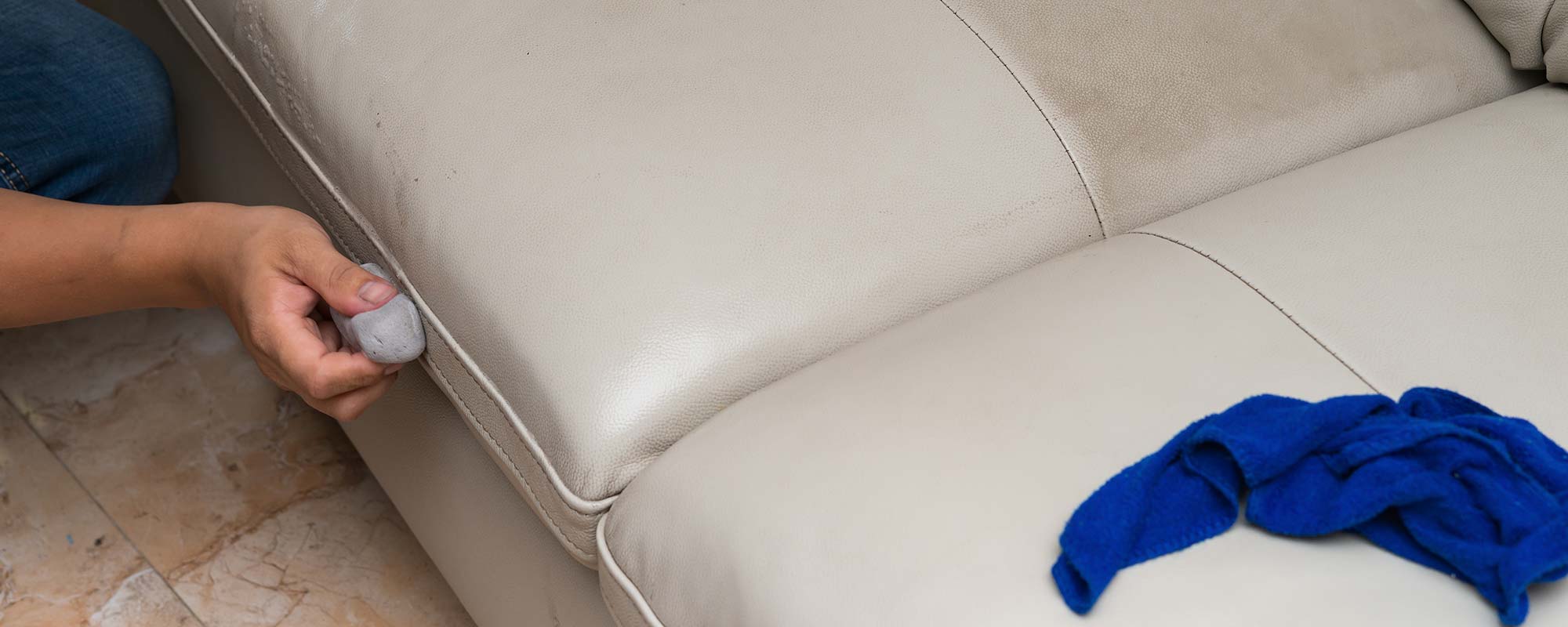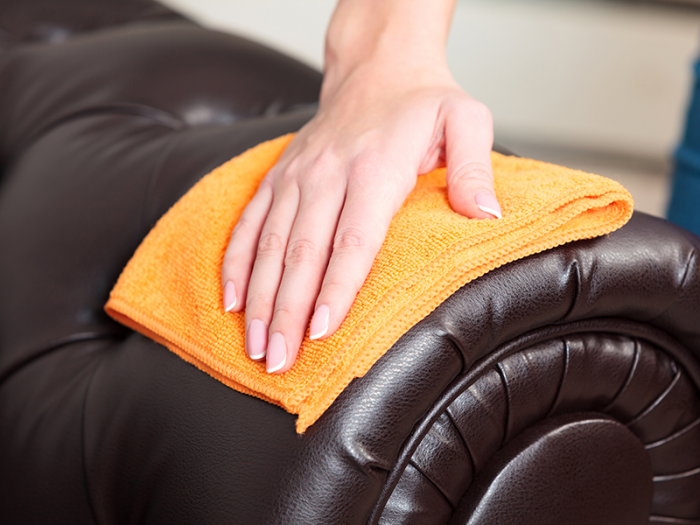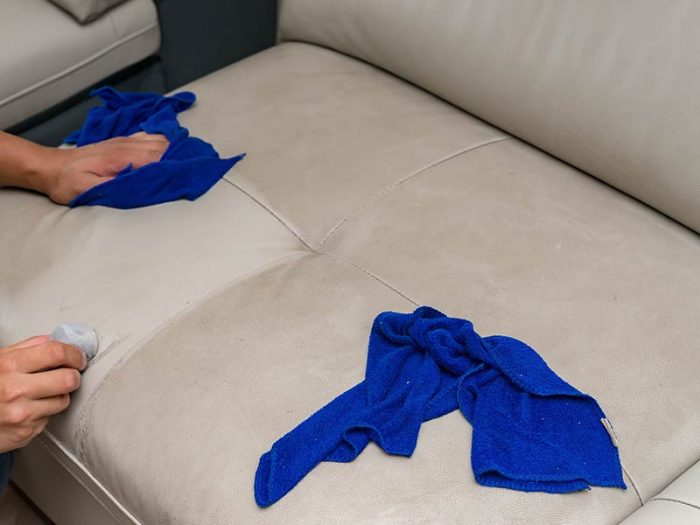
Leather cleaning
Leather is cleaned and the conditioner replaces natural oils, restoring suppleness and helping protect against cracking and stains. Leather cleaning has two major categories; sueded leather and smooth leather.
Sueded Leather
Sueded leathers have had the hair removed, tanned and the flesh side of the skin rubbed by an abrasive wheel to raise nap. The three most common types of leather which are sueded are: sheepskin, pigskin, and cowhide. All types are easily stained from spillage. Pigskin generally does not respond to cleaning as well as cowhide or sheepskin.
Smooth Leathers
This type of skin has had the hair removed, tanned, and the hair side dyed and or dressed with a finish. Depending on the finish used needs to be identified so that the correct cleaning process can be identified. The three types are aniline, pigmented and unfinished leather.
Aniline leather
Generally, hides are finished using aniline dyes when the leather has a fine full grain characteristic. A light transparent coating is applied so that the natural grain of the leather shows through, while the aniline dye acts like a protective top coat. Most aniline leather can be cleaned, but wear and cleaning may dull certain finishes. So before we clean we will pre-test in an inconspicuous area first and qualify.
Pigmented Leather
Selected pigments are added to create an opaque effect. This effect upgrades hides of coarser grain. The hides may have a flat or glazed appearance depending on the chemicals used to finish. Between a glossy or matte finish there are many variations.
Pigmented leather is the most durable and serviceable hence the most common type used in upholstery.
Because of the advancement in the coatings substances used on leather it has meant that leather is more resistant to abrasion and staining.
Unfinished leather
This is constructed by dying into the skin only. No finish is added to the leather. It is very soft, dry and porous. It is hence the least serviceable of the smooth leathers. It will scuff easily, absorb soil, and stain from liquid spills. Cleaning may darken the lighter colours, and will only be done on a customer risk basis only.
Pre-inspection
Blemishes
We will pre-inspect all leather upholstery prior to cleaning as leather comes to the consumer second hand the animal has first used the skin and the skin may have blemishes. These may have occurred during the life of the animal when it was bruised or wounded in some way by insects or barbed wire for instance. As the skin heals a heavier scar tissue develops which during the tanning process does not accept dyes as readily as the rest of the hide.
To mask these blemished areas the manufacturer will sometimes apply a surface dye which are not always colourfast. So during the cleaning process there may be a loss of dye in these areas. This is outside our liability as cleaners, as it is a pre-existing condition from the time of manufacturing.
Weak Thin Skins
Weak areas are caused in the upholstery due to differences in hide weight and texture from hide to hide and even area to area on the same hide. These areas may not be evident before cleaning, but become exposed after.
Shrinkage
Due to a gradual drying as natural oils are lost leather skins have a natural tendency to slightly draw up and contract. Cleaning leather will replace some of the oils and assists in extending the life of the leather. We will always pre-inspect for shrinkage, cracking, peeling etc before cleaning.
Sunfade
The dyes used in tanning of skins are sensitive to light and some colours will fade considerably in normal wear.
Antiquing
Cleaning may possibly change the shading and pattern as this finish is created after the original base colour is applied, by spraying or rubbing a darker coat to the surface in an uneven coating to create a distinctive mottled appearance. Also the colour may be slightly lighter or darker and the feel or of the leather may change slightly hence pre-testing first.
Tipping
Like antiquing, a finish is applied after the original base colour. However the finish is applied to the upper surface of the hide, resting on the tips not in the lower pores of the skin. It is a finishing method which has a reverse look of antique. Cleaning cautions are the same as antique finish.
We will keep you informed about what we will do to your upholstery and expectation of the results of cleaning. We will explain prior to cleaning, potential loss of colour, gloss, sun fade etc. We will thoroughly inspect the upholstery for cracking, loss of dye finish, cuts, blemishes, lost buttons, nicks to wood, imperfections, spots or stains etc and qualify this with you the customer. Where possible we will also inspect inside cushions checking padding, seams and zips.
Cleaning Analine
Because leathers only have light surface protection they will absorb dirt and spillages more readily, this will make cleaning less effective because dirt will only clean off leather, not out of it. If a regular regime of cleaning and protecting is maintained the stains will blend into the general look of the furniture (very pale colours may be an exception to this generalisation)
Apply rich foam to an area and gently agitate, do not over wet.
After cleaning it is advisable to treat all Aniline types with a surface protection. Wax and oil surfaces may be treated with “Waxon” or “oleosa”, other types with “leather protector” (available through sheen services)
Aniline leathers are subject to UV fading no matter how carefully it is maintained and will continue to do so even after restoration. There is a range of Aniline Dyes specifically to combat or remedy this problem.
Cleaning pigment/protected
Pigments are designed to be serviceable and will usually clean well.
Clean with rich foam and protect afterwards.
CAUTION
- Two tone sauvage, and antique finishes, even on new leather can sometimes be delicate and wash of (always test product first)
- Excessive body oils (from hair, skin etc) show as dark areas that scratch pale when scratched. These will not clean off and will require special treatment beyond simple cleaning.
Cleaning nubuck
Because Nubuck is very sensitive leather it is essential to follow a strict maintenance regime to ensure the leather retains its look and soft texture.
All Nubuck should be treated with NUBUCK PROTECTOR from the outset.
Cleaning is a difficult process and should be left to the professionals. What can be done is a regular treatment with a NUBUCK
CLOTH. This is a simple effective and safe way to care for Nubuck Leather.
Never attempt to clean Nubuck leather with solvent cleaners. They will only dissolve the dirt and drive it deeper into the leather.


